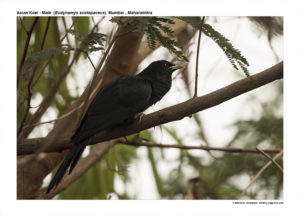Asian Koel (male)

Asian Koel Eudynamys scolopaceus
Etymology :
- Eudynamys : Greek eu -fine; dunamis – power, strength
- Scolopaceus : Latin word snipe-like,stripe-backed, long-billed.
Vernacular names : Hindi, Pun: Koel, Ben: Kokil, Ass: Kokil, Kuli, Guj: Koyal, Mar: Kokil, Kokila, Ori: Koili, Ta: Kuyil, Te: Kokila, Mal: Kuyil, Kan: Kogile, Sinh: Koha, Gomera koha, Mald: M: Karlu koel, F: Dindin koel
Distribution in India: Resident of Western Ghats, Eastern Ghats and some parts of Tamilnadu, Andhra Pradesh. Also resident of Lower Himalayas and North Eastern states
Description: Size of 31- 32 cm. Adult male is glossy black, iris red, bill light green, feet grey. Female is dark brown above with many white spots and bars, crown rufous with whitish streaks, tail barred black and brown; white below, throat spotted, breast and belly barred blackish brown.
Habitat: It is found in open forest, coastal swamp forest, edge and scrub, gallery forest, riverside scrub, plantations, orchards, gardens in towns and near human habitations, especially around figs and other fruiting trees, and mangroves.
Food Habits : It eats fruits, including figs, berries, Papaya , Tamarinds and oil palm nuts and other palms.They also eat a few insects like grasshoppers, mantids, stick-insects, caterpillars, snails. It also eats flower nectar as well as flowers .The female also eats eggs of other birds. It is arboreal, feeds in tree canopy.
Breeding Habits: They breed in May-June. Brood-parasitic: hosts are House Crow and Jungle Crow. It has shorter incubation period than crows (13–14 days, against 16–20) .This allows Koel’s egg to hatch first. The Koel nestlings do not evict, but decrease host’s success, so that usually 1–2 of its own chicks starve. The nestling period is 19–28 days, and may be fed another 2–3 weeks post-fledging; Adult female cuckoos will feed fledged juveniles.